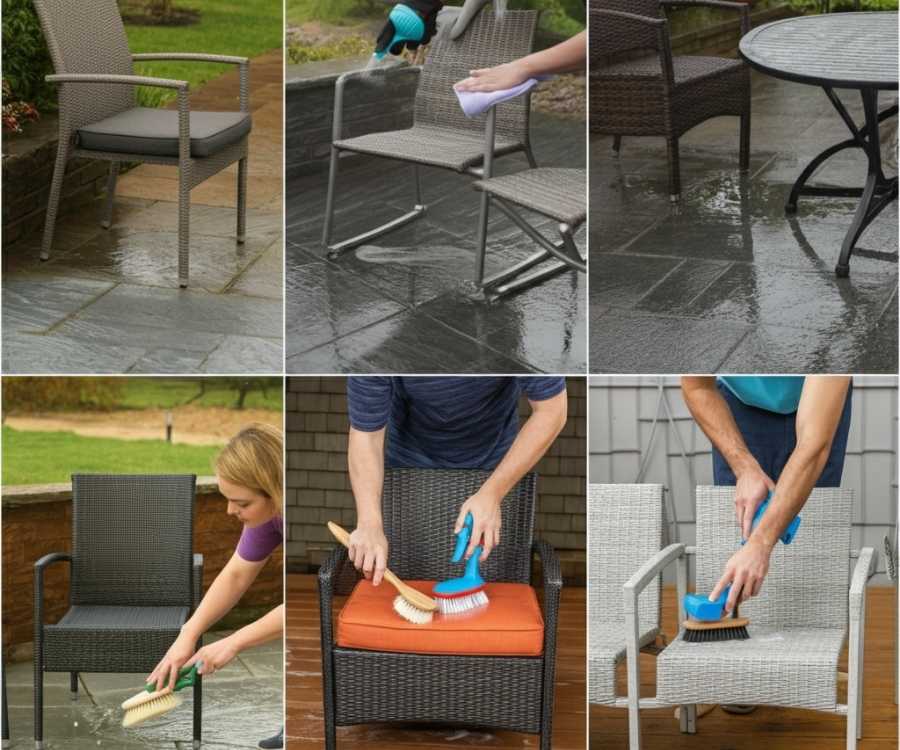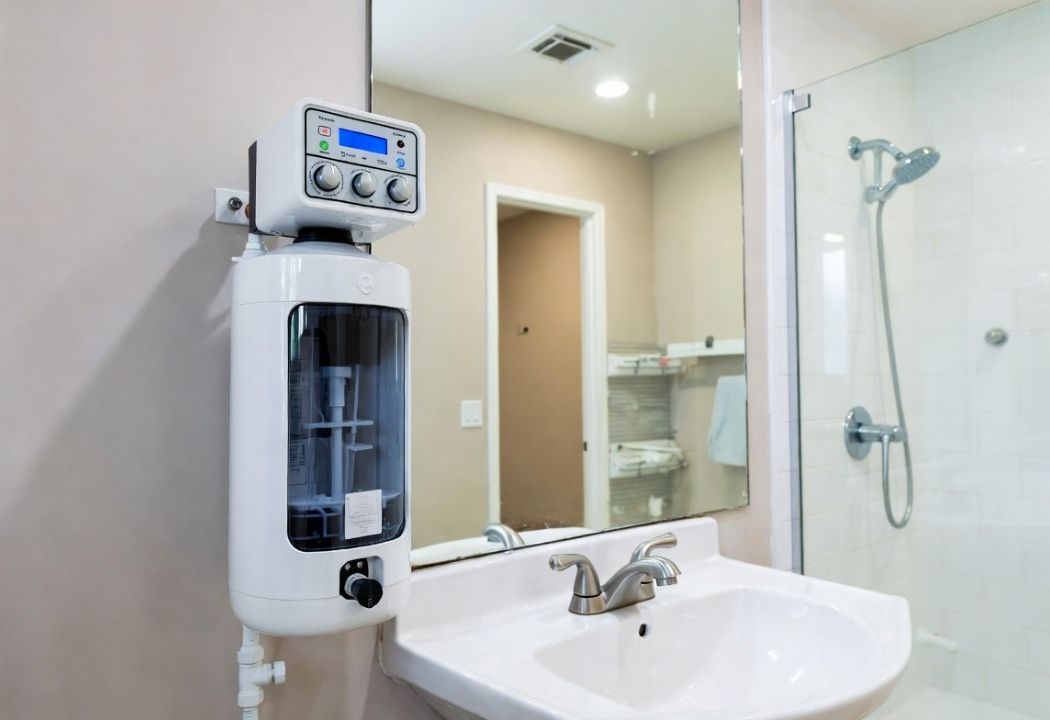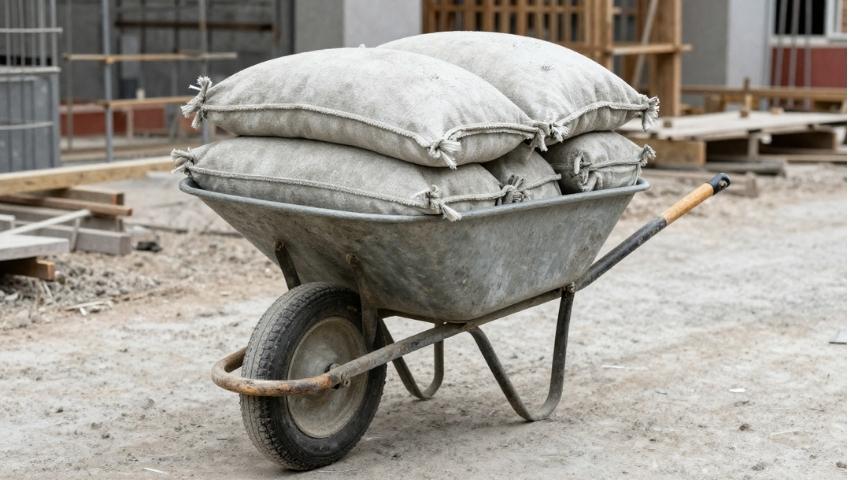Spring has arrived, and it’s time to reclaim your outdoor space. But as you step onto your patio, you’re greeted by furniture that’s seen better days—covered in dirt, pollen, mildew, and the remnants of last season’s neglect. Don’t worry; with the right approach, you can restore your patio furniture to its former glory.
This comprehensive guide will walk you through cleaning methods for every type of patio furniture, including aluminium, wicker, teak, and plastic. You’ll learn which cleaning solutions work best for specific materials, discover preventive maintenance tips, and find out how to tackle stubborn stains that seem impossible to remove.
Whether you’re dealing with a light dusting or severe grime buildup, these proven techniques will help you maintain beautiful outdoor furniture that lasts for years to come.
Essential Cleaning Supplies for All Patio Furniture
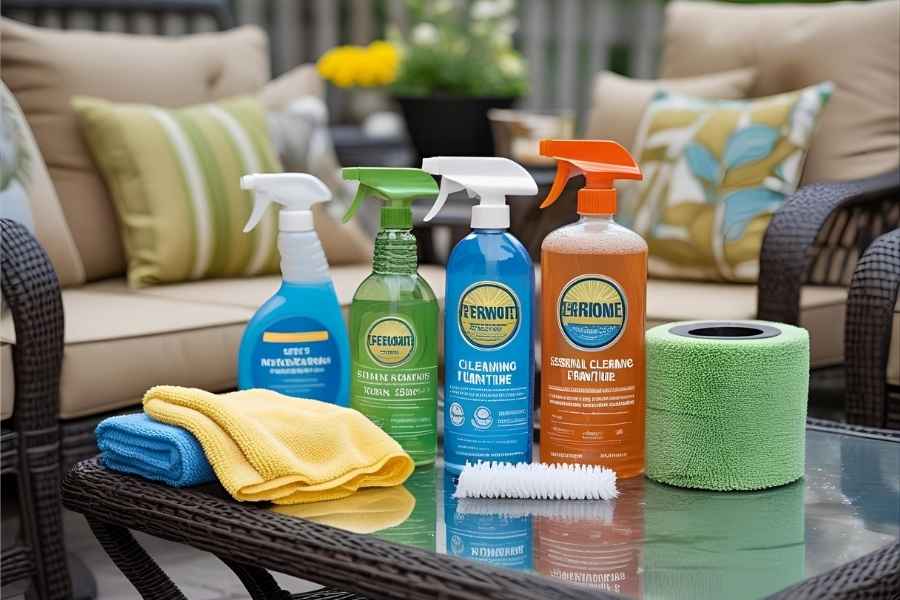
Before diving into material-specific cleaning methods, gather these basic supplies that work across multiple furniture types:
Basic cleaning arsenal:
- Mild dish soap
- White vinegar
- Baking soda
- Soft-bristled brushes (old toothbrushes work great)
- Microfiber cloths
- Garden hose with spray attachment
- Bucket for mixing solutions
For tougher jobs:
- Oxygen bleach (colour-safe bleach)
- Magic eraser sponges
- Pressure washer (use with caution)
- Commercial outdoor furniture cleaner
Having these items on hand ensures you’re prepared to tackle any cleaning challenge your patio furniture presents.
How to Clean Aluminium Patio Furniture
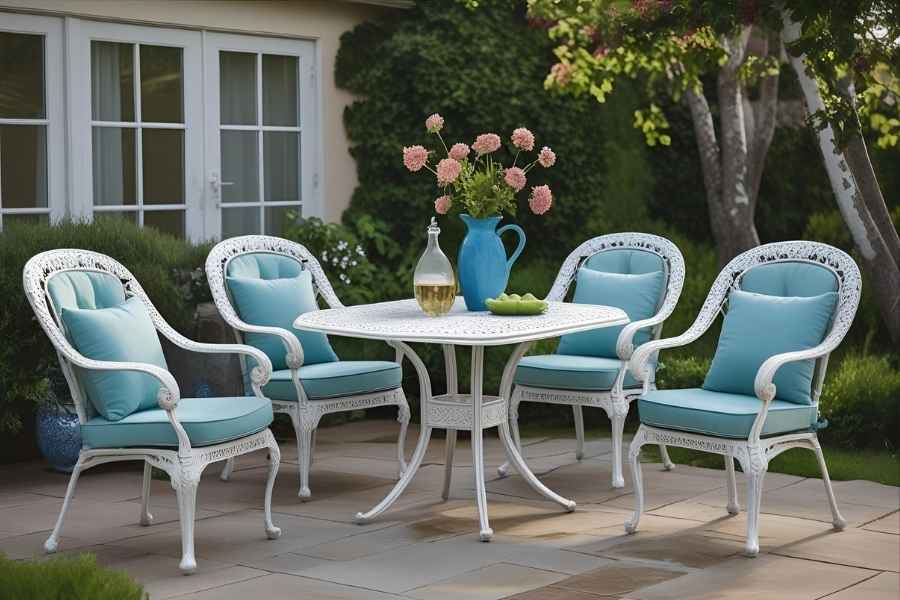
Aluminium furniture is popular because it’s lightweight, rust-resistant, and relatively low-maintenance. However, it can develop water spots, oxidation, and stubborn grime over time.
Regular aluminium cleaning
Start with a simple solution of warm water and mild dish soap. Mix two tablespoons of dish soap in a gallon of water. Using a soft cloth or sponge, wipe down all surfaces, paying particular attention to joints and crevices where dirt tends to accumulate.
Rinse thoroughly with clean water and dry with a soft towel to prevent water spots from forming. For best results, clean aluminium furniture monthly during peak outdoor season.
Removing oxidation and tough stains
If your aluminium furniture has developed a chalky white residue (oxidation), create a paste using baking soda and water. Apply the paste to the affected areas and let it sit for 15 minutes before gently scrubbing with a soft brush. Rinse thoroughly and dry.
For extremely stubborn stains, mix equal parts white vinegar and water in a spray bottle. Spray the solution on the problem areas, let it sit for 10 minutes, then scrub and rinse thoroughly. The acid in vinegar breaks down mineral deposits and grime effectively.
Cleaning Wicker and Rattan Furniture
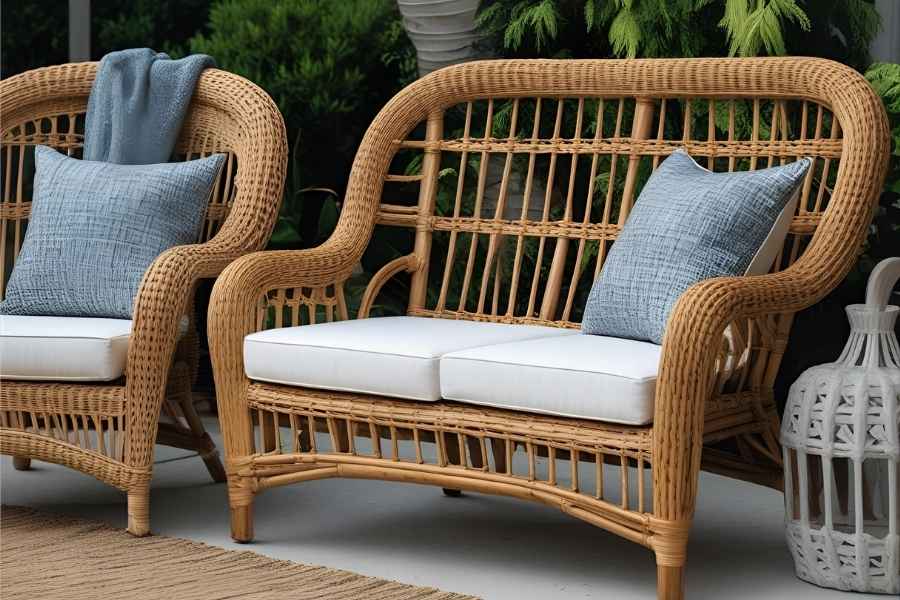
Wicker and rattan furniture add natural charm to any outdoor space, but their woven construction can trap dirt and debris. The cleaning approach depends on whether you have natural or synthetic wicker.
Natural wicker care
Natural wicker requires gentle handling to prevent damage. Start by removing loose dirt with a vacuum cleaner using the brush attachment. Work carefully around the weave to avoid snagging.
Create a mild cleaning solution by mixing one part white vinegar with three parts warm water. Dip a soft cloth in the solution, wring out excess moisture, and wipe down the furniture. Natural wicker should never be soaked, as excessive moisture can cause warping and mould growth.
For stubborn spots, use an old toothbrush dipped in the cleaning solution to gently scrub the area. Always work in the direction of the weave, not against it.
Synthetic wicker maintenance
Synthetic wicker is more durable and can handle stronger cleaning methods. Start with the vacuum method described above, then wash with warm soapy water using a soft brush.
For deep cleaning, synthetic wicker can handle a pressure washer on a low setting. Keep the nozzle at least two feet away from the surface and use a wide spray pattern to avoid damage.
After cleaning, allow the synthetic wicker to air dry completely before using or covering it.
Restoring Teak Patio Furniture
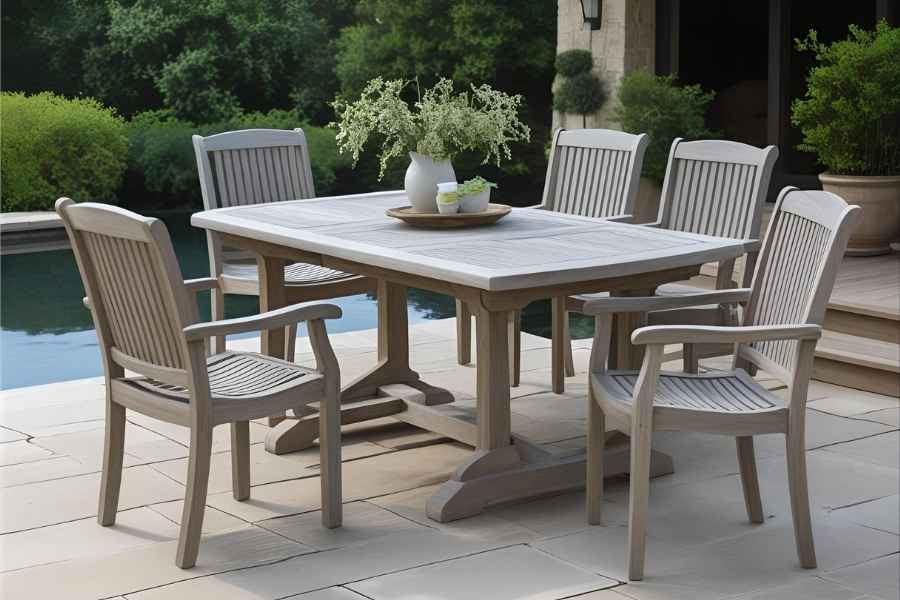
Teak is prized for its natural oils that resist insects and moisture, but it requires special care to maintain its beautiful appearance. Over time, teak naturally weathers to a silver-grey colour, which many people prefer. However, if you want to restore the original golden colour, follow these steps.
Basic teak cleaning
Never use soap or detergent on teak, as these can strip the natural oils from the wood. Instead, scrub teak furniture with a stiff brush and plain water. Work in the direction of the wood grain to avoid scratches.
For weekly maintenance, simply rinse with water and let air dry. This prevents dirt buildup and maintains the wood’s natural appearance.
Deep cleaning weathered teak
If your teak furniture has developed black spots or heavy staining, you’ll need a specialised teak cleaner. These products are designed to remove stains without damaging the wood’s natural properties.
Apply the teak cleaner according to manufacturer instructions, typically letting it sit for 10-15 minutes before scrubbing with a brush. Always work in the direction of the grain and rinse thoroughly afterwards.
Restoring the golden colour
To restore teak’s original golden hue, use a two-step process: first, apply teak cleaner, followed by teak brightener. The cleaner removes dirt and oxidation, while the brightener restores colour.
After cleaning and brightening, allow the wood to dry for 24-48 hours before applying teak oil or sealer if desired. However, many teak enthusiasts prefer to let the wood weather naturally without any finish.
Plastic and Resin Furniture Cleaning
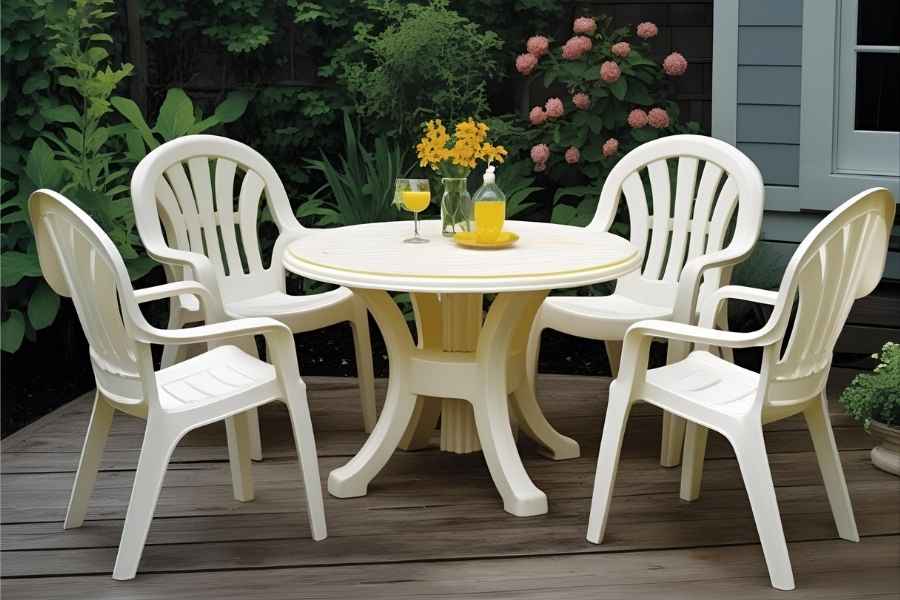
Plastic and resin furniture are affordable and weather-resistant, but they can become discoloured and chalky over time. White plastic furniture is especially prone to yellowing and staining.
Standard plastic cleaning
Mix warm water with mild dish soap and scrub with a soft brush. For textured surfaces, use an old toothbrush to get into grooves and patterns. Rinse thoroughly and dry with a clean towel.
This basic cleaning should be done every few weeks during periods of heavy use to prevent the buildup of dirt and oils.
Removing stubborn stains and discolouration
For yellowed or heavily stained plastic furniture, try these methods:
Baking soda paste: Mix baking soda with enough water to form a thick, paste-like consistency. Apply to stained areas, let sit for 30 minutes, then scrub and rinse.
Vinegar solution: Mix equal parts white vinegar and warm water. Spray on the stain, let it sit for 15 minutes, then scrub and rinse.
Magic Eraser: These melamine foam sponges can effectively remove scuff marks and surface stains. Wet the sponge and gently rub stained areas.
Dealing with mould and mildew
If plastic furniture has developed mould or mildew, create a solution of one part bleach to ten parts water. Apply with a spray bottle, let sit for 10 minutes, then scrub and rinse thoroughly. Always wear gloves and work in a well-ventilated area when using bleach.
Wrought Iron and Steel Furniture Care
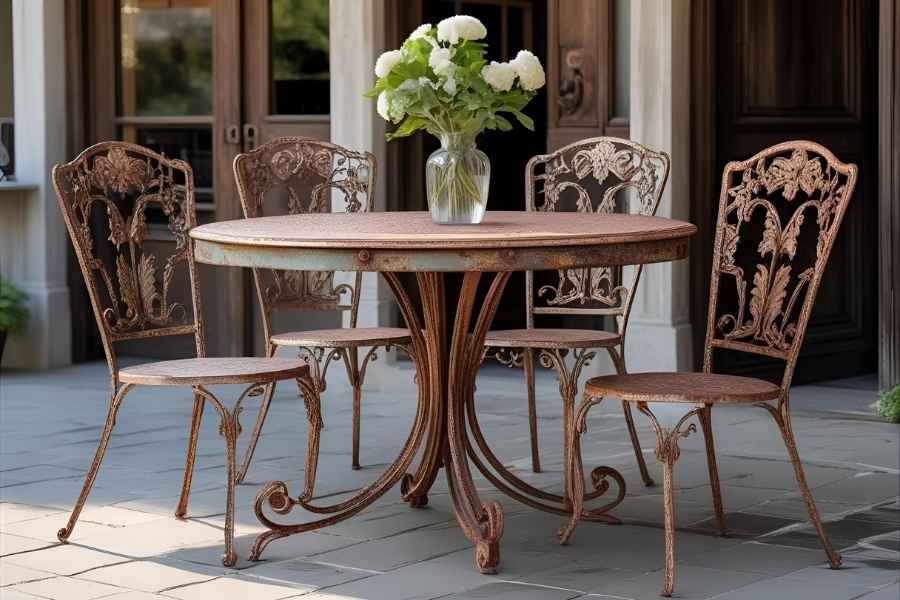
Metal furniture, such as wrought iron and steel, can develop rust if not correctly maintained. Regular cleaning and inspection help prevent severe damage.
Routine metal furniture cleaning
Wash with warm soapy water and a soft cloth or sponge. Pay special attention to joints, bolts, and decorative elements where water might collect. Rinse thoroughly and dry completely to prevent water spots and rust formation.
Rust prevention and removal
Inspect metal furniture regularly for signs of rust, especially after winter storage. Small rust spots can be removed with fine steel wool or sandpaper. After removing rust, clean the area thoroughly and apply touch-up paint designed for outdoor metal surfaces.
For furniture with extensive rust, consider having it professionally sandblasted and repainted, or replace severely damaged pieces.
Protecting metal finishes
Apply car wax to painted metal furniture twice a year to protect the finish and make future cleaning easier. The wax creates a barrier that repels dirt and moisture while adding shine.
Fabric and Cushion Cleaning Tips
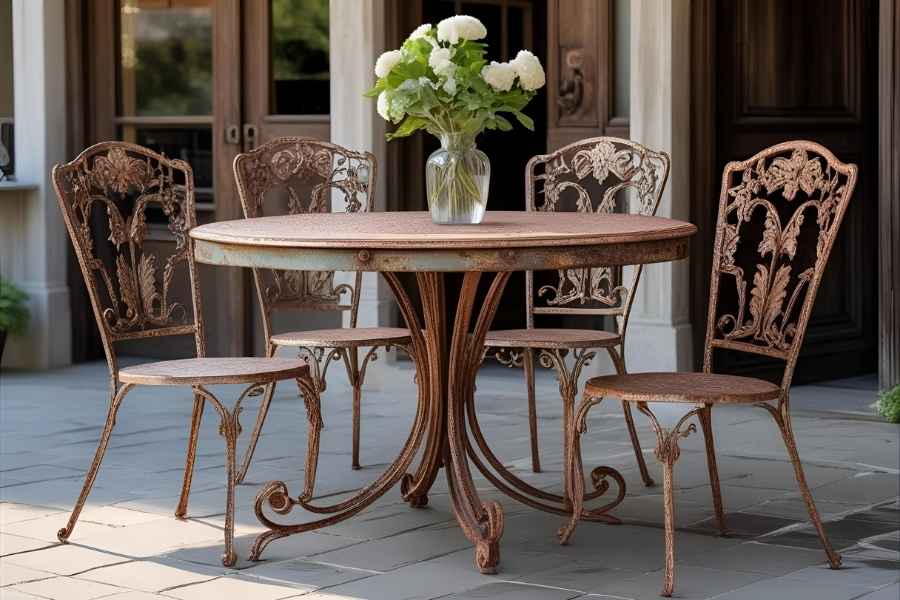
Outdoor cushions and fabric elements require special attention to prevent mould, mildew, and permanent staining.
Regular fabric maintenance
Remove cushions and fabric covers regularly to allow them to air out and prevent moisture buildup. Shake out loose dirt and debris weekly, and vacuum monthly using the upholstery attachment.
Washing outdoor fabrics
Check care labels first, but most outdoor fabrics can be machine washed in cold water with mild detergent. Avoid using fabric softeners, as they can diminish the water-repellent properties of your clothing.
For spot cleaning, mix one tablespoon of liquid laundry detergent with one cup of warm water. Apply with a clean cloth, blotting gently (don’t rub), and then rinse with clean water.
Removing mould and mildew from fabrics
For mouldmould and mildew on outdoor fabrics, create a solution of 1 cup white vinegar and 1 cup warm water. Spray the affected area, let it sit for 15 minutes, then scrub gently with a soft brush. Rinse thoroughly and allow to air dry completely in direct sunlight.
Seasonal Deep Cleaning Schedule
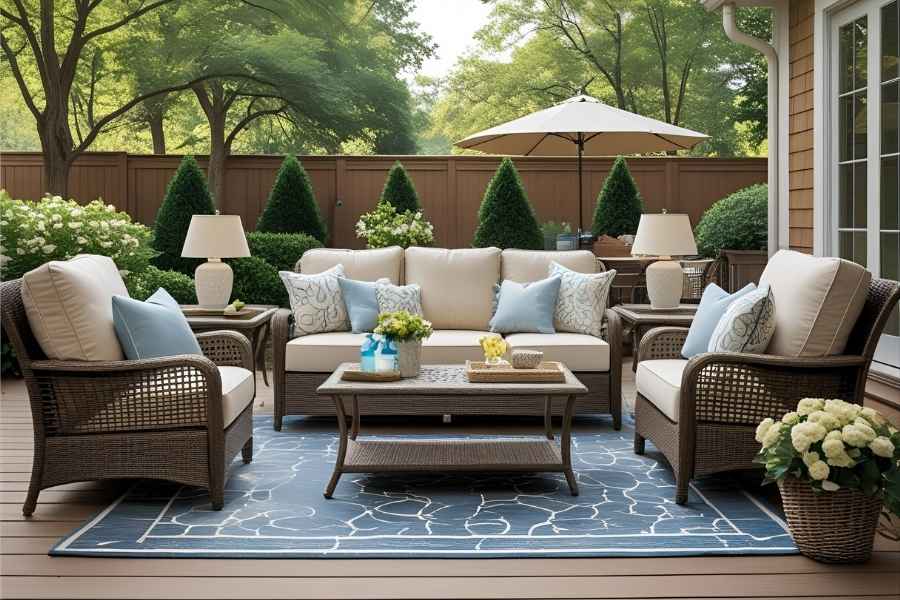
Maintaining a regular cleaning schedule not only extends the life of your furniture but also keeps your outdoor space inviting year-round.
Spring preparation
After winter storage or months of neglect, give all furniture a thorough inspection and deep cleaning. Check for damage, rust, loose joints, or worn areas that need attention.
Clean thoroughly using the methods appropriate for each material, and make any necessary repairs before the outdoor season begins.
Mid-season maintenance
During the peak outdoor season, clean furniture monthly or as needed, depending on usage. Focus on high-touch areas, such as armrests and table surfaces. Remove stains promptly before they become permanent.
Fall preparation
Before storing furniture or covering for winter, clean everything thoroughly and allow it to dry completely. Apply protective treatments, such as wax or oil, if recommended for your furniture type.
Long-Term Furniture Protection

Proper protection extends the life of furniture and reduces the frequency of cleaning.
Covers and storage
Invest in high-quality furniture covers made from breathable materials. Covers should fit snugly but allow air circulation to prevent mould and mildew growth.
When possible, store furniture in a dry, well-ventilated area during periods of harsh weather or the winter months.
Regular inspections
Check furniture monthly for signs of damage, wear, or developing problems. Early intervention prevents minor issues from becoming major repairs.
Look for loose bolts, cracked joints, rust spots, or fabric damage that needs attention.
Transform Your Outdoor Space
Clean, well-maintained patio furniture transforms your outdoor space into an inviting extension of your home. By following the material-specific cleaning methods outlined in this guide and establishing a regular maintenance routine, you’ll keep your furniture looking great for years to come.
Remember that different materials require different approaches, so always identify the type of furniture before choosing cleaning products. When in doubt, start with the gentlest method and work up to stronger solutions if needed.
Your outdoor furniture is a valuable investment in your home’s comfort and overall value. With proper care and regular attention, it will provide years of enjoyment and relaxation in your outdoor oasis.







